Did you play Yu-Gi-Oh! on the playground with your friends? Is new Yu-Gi-Oh! too complicated for you? Do you just want to relive those old school yard days? Then have I got the format for you!
Good evening (or morning, or afternoon, or whatever. Time is a flat circle back off.), my dear duelist. I come to you today with one of the most elegant ways to play our beloved card game of Yu-Gi-Oh. If you recall from my Getting Started article I discussed a variety of the card game rules called Time Wizard Format. What I am about to show you is one of the most popular varieties of Time Wizard Format that duelists play. Duelists were playing this format long before Time Wizard was officially sanctioned by Konami. I bring to you, the Yu-Gi-Oh! format using cards and ban lists through the summer of 2005, Goat Format.
Why is it Called GOAT FORMAT?
Well that’s just because it’s the greatest of all time! Some duelists may say this. I won’t disagree with them. The real reason is because of the best deck of the time: Goat Control.
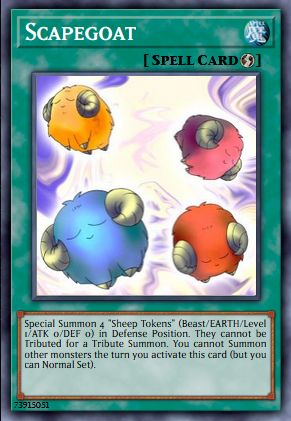
Goat Control used a combination of Scapegoat and Metamorphosis to control the field and keep advantage on the opponent. The key monsters in the strategy are Thousand-Eyes Restrict (TER) in the, to use era appropriate terms, Fusion Deck and the spirit monster Tsukuyomi in the Main Deck.
TER is a powerhouse as it shuts down your opponent’s aggro deck, stopping all monsters except for itself from attacking or changing their battle position. In addition it can take one of your opponent’s monsters and equip it to itself. This is a phenomenal form of removal that few cards can avoid. Getting this beast onto the board is simply a matter of baiting your opponent into attacking you while you have Scapegoat set, nullifying their battle phase with chump blockers, then activating Metamorphosis using a token as tribute to summon TER.

This is where Tsukuyomi comes in. Tsukuyomi is a spirit monster, which means it cannot be special summoned and in the end phase it returns to your hand. This may seem like a disadvantage, but when you consider it’s actual effect you’ll see how strong the card is. Whenever Tsukuyomi is Normal Summoned it targets one monster on the field and puts it in face-down defense position. Now if your TER has equipped an opponent’s monster, you can summon Tsukuyomi and flip TER face-down. This will send the monster equipped to TER to the graveyard. In that same turn (if TER hasn’t already attacked or if it is not the same turn TER was summoned) you can flip TER into face-up attack position allowing you to equip a new monster to TER! Tsukuyomi will bounce back top your hand in the end phase and you can just keep this loop going!
What is Goat Format?
As I stated previously, Goat Format is a version of Yu-Gi-Oh! using the card pool and banlist existing through August 6, 2005 when the Cybernetic Revolution expansion was released. You may think that is an arbitrary cut-off date. The reason is because of Cyber Dragon. Cyber Dragon literally changed everything. Cyber Dragon completely redefined what a Yu-Gi-Oh! card could be.
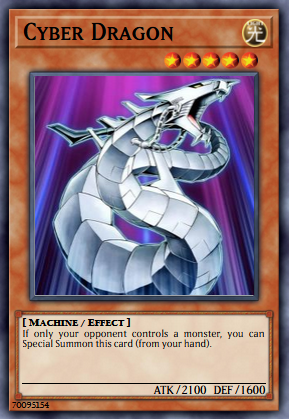
The reason this bastard card’s release is the cut-off for the format is due to Goat Format having a heavy emphasis on the game’s tempo, that is both players trading blows and cards top maximize their card advantage until one player out resources the other, or one player stops having answers to the other’s threats.
Card Advantage and THE TRINITY
Card advantage is the core conceit of the format. Earlier Yu-Gi-Oh! Was relatively simple. Sure there were cards that had crazy effects and had judges called over for questions constantly, but it was also a much slower game that it is today. Card advantage is the concept of counting how many cards you are getting/removing from your opponent when activating your own cards or summoning your own monsters.
For example: If I were to summon Celtic Guardian, that is a -1 in card advantage as I’ve removed one card from my hand without getting anything in return. However, if I summon Breaker the Magical Warrior and activate his effect to destroy one of my opponent’s spell/trap cards on the field, then that is a net 0 in card advantage as I’ve summoned a monster (-1), but in turn removed a resource from my opponent (+1).
This concept is what makes the trinity of Goat Format a staple in any deck you might want to play: Pot of Greed, Graceful Charity, and Delinquent Duo.
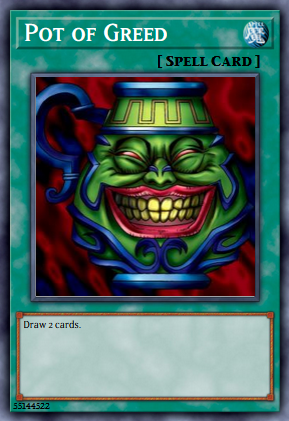
Pot of Greed is an inherent +1. It’s the perfect card.
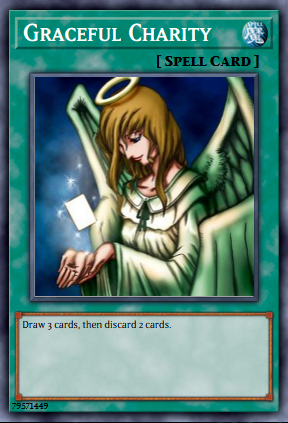
Graceful Charity, however may seem like a negative in card advantage, but when you do the math it’s actually a net 0. Activate Graceful (-1) -> draw 3 (+3) -> discard 2 (-2), do the math and that’s a net 0 AND you’ve dug 3 cards into your deck. If you still think Graceful isn’t that good, consider that you might have cards in your hand that are absolutely worthless. You just get to discard those for free!
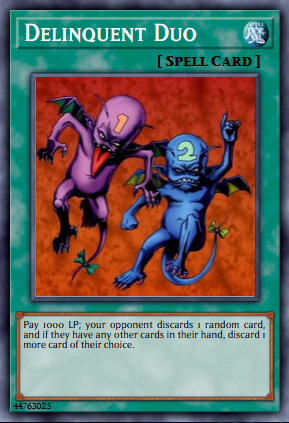
Delinquent Duo is the third and final part of the trinity. If you see this card going first against your opponent, then they’re going to have a bad time. Duo is a +1 in card advantage. This isn’t because you are drawing cards, but because in response to you spending one card your opponent is losing 2. Sometimes this is better than Pot of Greed. Depending on what you discard this can be worse too. For that reason some decks decide to omit Delinquent Duo. Many decks have discard fodder that can help them eat a duo without breaking a sweat. Which brings me to another staple card.
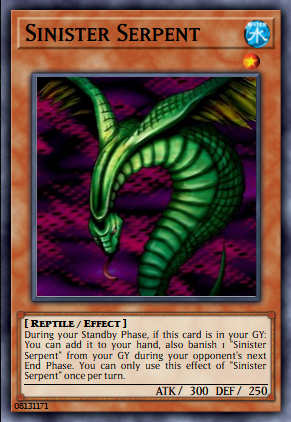
Sinister Serpent is a powerful card in this format. Its recursion in the Standby Phase means you can use it as a chump blocker to stall for an answer, or you can use it as discard fodder to effectively plus on your cards that require a discard for their effects.
Strategies
This is only one deck strategy you can employ when playing Goat Format. There are loads of strategies you can try out, some better than others, but all are valid nonetheless.
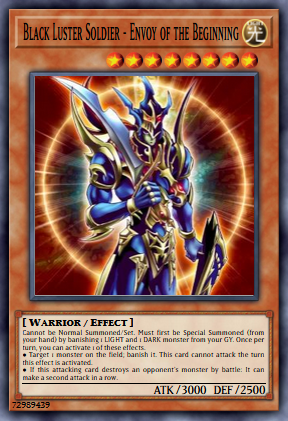
Popular Strategies include:
- The aforementioned Goat Control and variants therein.
- Chaos Control – A strategy where you use light and dark monsters to gain advantage fill your graveyard to eventually summon Chaos Sorcerer for control, and the powerful Black Luster Soldier – Envoy of the Beginning to close out games.
- Warrior aggro – a deck strategy that abuses the power and consistency of warrior monsters to break down your opponent’s defenses. This strategy can also play a decent enough suite of lights and darks to make use of Black Luster Soldier – Envoy of the Beginning
- Flip control – a strategy where the duelist will set many flip monsters, usually light and dark flip monsters, with powerful flip effects to control the game until you can summon Black Luster Soldier – Envoy of the Beginning. This deck also makes great use of Tsukuyomi in order to reset your flip monsters.
There are even more decks than this to choose from, but the basic goal of all the decks remains the same: keep better card advantage than your opponent for as long as you can.
If you want to peruse ideas for decks then I highly suggest the premier Goat Format resource goatformat.com. The website has more in-depth information on the format as well as a wealth of usable decks.
Start Dueling!
At this point I you’ve found a deck you like, you’ve accumulated the cards necessary, and now you’re itching to get your fix of old school Yu-Gi-Oh! and relive those glory days. This is always easier said than done. Thankfully Goat is an extremely popular format. Any duelist you talk to is likely to have a Goat deck waiting in the wings in order to burn time in-between rounds. If you’re extra lucky your local game store might be running official Time Wizard tournaments and you can get your Goat fix in weekly. If you aren’t so lucky, then you might have some work to do. You’re gonna have to start up your own scene, but all you have to do is give a little push to the local community and they assuredly will show up in numbers worthy of your LGS’s attention. As an example my local scene only started 4 months ago. It was going to start as a monthly event for my store, but the turn out was so good the first night that the manager decided to run the event weekly. From there the community grew from 8 weekly participants, to 12, to 16! If my store could hold tournaments on Saturdays then the turnout could even double from there! Duelists love this format and if you can gather people together to play at all, then I’m sure you can get a larger scene going in no time.
Tournament Report
Now that you have an idea of what the format is let me blindside you with a tournament report. Remember earlier when I said time was a flat circle? Well I went undefeated in a 16 player tournament at my local store one time, and that means I’m always undefeated forever. You may be wondering how I achieved this. Well it’s all thanks to an absolutely kick ass card called:
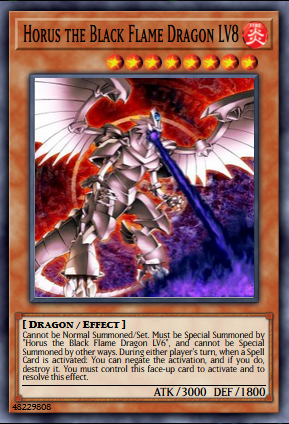
Now this isn’t a typical build around for Goat format, but I had been playing for a couple of months and was getting bored with playing plain old Chaos Control (a very fun deck mind you and I will play it again in the future). Horus is one of those classic monsters that don’t see play in modern Yu-Gi-Oh! (also known as Advanced Format) so I made it my mission to build a deck using this beast and take him at least to a top 4 finish at my local tournament.
Main Deck (40)
1x Breaker the Magical Warrior
1x Fusilier Dragon, the Dual-Mode Beast
1x Horus the Black Flame Dragon LV8
2x Horus the Black Flame Dragon LV6
3x Horus the Black Flame Dragon LV4
1x King Tiger Wanghu
2x Kycoo the Ghost Destroyer
2x Magician of Faith
1x Mirage Dragon
1x Sangan
1x Sinister Serpent
1x Tribe-Infecting Virus
2x Book of Moon
2x Creature Swap
1x Delinquent Duo
1x Graceful Charity
1x Heavy Storm
2x Metamorphosis
1x Mystical Space Typhoon
2x Nobleman of Crossout
1x Pot of Greed
1x Premature Burial
1x Scapegoat
1x Snatch Steal
1x Stamping Destruction
1x Call of the Haunted
1x Mirror Force
1x Ring of Destruction
2x Royal Decree
1x Sakuretsu Armor
Extra Deck (15)
1x Charubin the Fire Knight
1x Darkfire Dragon
1x Dark Balter the Terrible
1x Dark Blade the Dragon Knight
1x Fiend Skull Dragon
1x Gatling Dragon
2x King Dragun
1x Master of Oz
1x Ojama King
1x Reaper on the Nightmare
1x Ryu Senshi
1x The Last Warrior from Another Planet
2x Thousand-Eyes Restrict
Side Deck (15)
1x Fusilier Dragon, the Dual-Mode Beast
1x Morphing Jar
2x Night Assailant
1x Book of Moon
1x Card Destruction
1x Metamorphosis
2x Scapegoat
2x Enemy Controller
3x Trap Dustshoot
1x Lightning Vortex
This is what I settled on. It certainly isn’t perfect and I made some changes subsequent to the tournament, but this list took me to the top. I look forward to playing my new and improved list to top cut finishes in the future.
The goal of the deck is to use Horus the Black Flame Dragon LV4’s ability to climb up to LV8 then lock my opponent out of spells and traps by activating Royal Decree and using LV8’s effect to negate all of my opponent’s spell cards. If I can manage it I will also use Metamorphosis to turn Fusilier the Dual-Mode Beast into King Dragun.
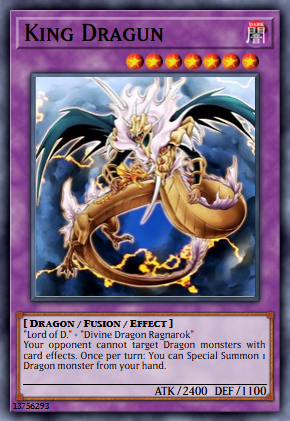
I did not manage to pull this off, but if I had Horus would have been untouchable as King Dragun protects him from monster effects. My with this list was to always side out the one copy of Fusilier and the Sangan. Sangan is a very powerful card, but in this build it is almost worthless with the only cards it can search out being Magician of Faith and Sinister Serpent. Both of those are good cards, but neither of them are cards I want to have in my hand so bad that I need to search for them.
The fusion deck is just a smattering of monsters that I can summon with metamorphosis either off of the levels of the monsters on my own field or the levels of monsters I steal from my opponent with Creature Swap or Snatch Steal.
Please forgive the relatively low detail as I am recalling games that occurred several days prior to writing this.
Round 1 Against Chaos Control: 2-0
My first round was really putting my deck to the test. I was facing the reigning champion of the store and his Chaos Control deck. This was the fastest match of my night, actually finishing our games with 18 minutes left in the round. Nothing extremely interesting happened here. I drew good cards and out resourced my opponent at every turn for 2 swift wins. This match was so unremarkable that I don’t remember if I summoned my boss monster or not. I was feeling pretty mighty after this one.
Round 2 Against Chaos Control: 2-1
After the first round going so well in my favor, round 2 felt like it would be a breeze. I was wrong. This was a 3 game slog. I lost game 1 as my opponent was able to out every threat I put up and I drew spells for 3 straight turns. Game 2 went in my favor but not without a fight. Game 3 ended up going into time. In Yu-Gi-Oh! what this means is that starting with the current turn, the game ends in 4 turns. Whichever player has more life points at the end of the fourth turn wins. At this point my life points were higher, but I had to maintain that lead. I end my turn with a Sinister Serpent face-down to wall out my opponent. On the return I am able to deal more damage, but not kill my opponent. I set up an insurmountable defense by setting more monsters and take the round.
Round 3 Against Chaos Control: 2-1
As much as I like playing against Chaos Control, three rounds in a row is a bit much. This is to be expected however. It’s one of the top decks in the format. This match is another close one. It doesn’t go into time, but at the end of game 3 my opponent misplays by not negating my Snatch Steal and instead allowing me to use Mystical Space Typhoon on his only back row and swing in for lethal.
Round 4 Against Chaos Cyber Stein Turbo: 2-0
The final round. I’m feeling really good now. I imagine so was my opponent. It was the first time he had been to the store for the tournaments and I was glad he was able to enjoy 3 rounds of wins. In game 1 I crush him utterly. He is able to get to one of his boss monsters, but I was holding on to Snatch Steal in order to take it and close out the game. Game 2 is a much different story. My opponent activates Last Will and triggers it by destroying his own Call of the Haunted, destroying his own monster. Off of Last Will he summons Cyber Stein from his deck. At 5,700 life points he activates Cyber Steins effect, paying 5,000 life points to special summon Last Warrior from Another Planet from his fusion deck. He is left with only the Last Warrior and 700 life points as he attacks my face-down monster. He passes his turn to me and seeing as how I can’t perform any sort of monster summon I activate Snatch Steal and take his Last Warrior and set a monster. I hold on for dear life, attack his face-down card, and pass the turn. On his turn he responds in-kind with a Snatch Steal of his own. I continue to set Sinister Serpent against his Last Warrior until I draw Creature Swap, putting the Last Warrior back under my control. Since neither of us can summon monsters my opponent concedes the game because he doesn’t have an out to the monster.
This was a very exciting night of Yu-Gi-Oh! I played 10 great games against great players and walked away with the top prize of a good chunk of store credit. I’m still working on perfecting this deck and I hope to have more results like this in the future.
Closing Thoughts
If you’re interested in Yu-Gi-Oh! at all I highly recommend you check this format out. Get a community growing in your local area. The more communities we have playing this format, the more reason we give Konami to sanction larger events. Right now the format is only played as a side event at Regional tournaments and Yu-Gi-Oh! Championship Series (YCS) tournaments. The format has lots of tournaments of its own, but they are all hosted by third parties. GoatFormat.com regularly posts tournament reports from these. If you want to know more about Goat and really dig in I highly recommend that site.
Until next time.
Have any questions or feedback? Drop us a note in the comments below or email us at contact@goonhammer.com.





